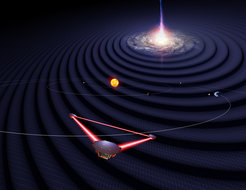LISA
LISA will be a mission of discovery – the first gravitational-wave observatory in space. It will gather entirely new information about the dark, invisible Universe and work hand in hand with other astronomical observatories in the 2030s.

The era of gravitational-wave astronomy began in 2015 with the first direct detection of a merger of two stellar-mass black holes. Observations by instruments on Earth are limited to frequencies above 10 Hz, while there are many sources that emit gravitational waves at lower frequencies, inaccessible from the ground.
A space observatory
LISA will be the first space-based gravitational-wave observatory. It will consist of three satellites spanning a triangular detector with 2.5 million kilometer long arms following the Earth on its orbit around the Sun. The satellites will measure distance changes caused by gravitational waves between test masses free falling inside the spacecraft. LISA will use laser light sent between the satellites to create the largest interferometer ever built. Key techonologies were tested and demonstrated by the LISA Pathfinder mission.
A rich source population
LISA will complement traditional astronomical observations based on the electromagnetic spectrum. The detector layout has been carefully chosen to allow observation of most of the interesting gravitational wave sources in the target frequency band between 0.1 mHz and 0.1 Hz, where the Universe is richly populated by strong gravitational wave sources:
- supermassive black hole binaries,
- small black holes circling and falling into much more massive black holes (extreme mass ratio inspirals, EMRIs),
- ultra-compact binaries in our Milky Way,
- stellar mass black hole binaries years before their merger,
- a stochastic gravitational-wave background, and
- unforeseen and completely unmodelled sources.
With these observations of gravitational waves from the depths of the entire cosmos, LISA will greatly enhance our knowledge about the beginning, evolution and structure of our Universe.
LISA research at AEI Hannover
AEI Hannover is leading in the development of LISA and in the LISA consortium. Karsten Danzmann, director at AEI Hannover, is the LISA consortium lead. In collaboration with the National Space Institute at Denmark's Technical University (DTU), AEI Hannover is developing and building the phase meter, one of the mission’s central hardware components. In addition, the institute is leading numerous large LISA subprojects and work packages in optical meteorology and interferometry. The institute has the world's largest laboratories for the LISA mission interferometry.












